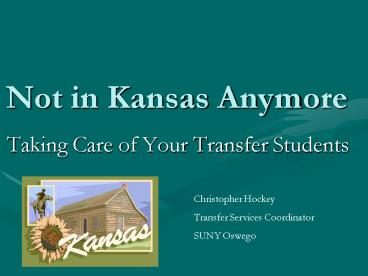Not in Kansas Anymore - PowerPoint PPT Presentation
1 / 19
Title:
Not in Kansas Anymore
Description:
What challenges do transfer students face? How can we improve the ... advantaged backgrounds. ... Facebook/Myspace transfer groups. Listservs. The ... – PowerPoint PPT presentation
Number of Views:52
Avg rating:3.0/5.0
Title: Not in Kansas Anymore
1
Not in Kansas Anymore
- Taking Care of Your Transfer Students
Christopher Hockey Transfer Services
Coordinator SUNY Oswego
2
Where We Are Headed
- Who are our transfer students?
- What challenges do transfer students face?
- How can we improve the transfer experience?
- Housing
- Socialization
- Transitional Programs
- Communication/Technology
- The Future of Transfers
- Discussion/Questions/Comments
3
Who Are Transfer Students?
- FIRST AND MOST IMPORTANT!
- NO TWO TRANSFER STUDENTS ARE ALIKE!
- About ½ of all CC students transfer to a 4-year
- Only 1/3 of those students transfer with an
associates. - 48 are racial and ethnic minorities.
- 74 of transfer students are 24 or older.
- 15-20 drop out within first year at 4 year.
- Only 15-20 of students intending to get
Bachelors actually do
4
Who Are Transfer Students?
- Many are coming from CCs with housing.
- Transfers engage in required, class-related
effective educational practices to same degree as
native students. - Transfers are less engaged in out-of-class
discretionary activities. - Life exigencies (work, family) may preclude
taking advantage of learning opportunities.
5
Who Are Transfer Students
- Come from less advantaged backgrounds.
- 1st generation college and 1st to graduate from
high school. - Extremely dependent upon financial aid and fewer
means to get it. - 57 of community college students work more than
20 hours per week. - 36 of community college students care for
dependents. - 21 of community college students commute (and
spend significant time doing so).
6
Do You Know Your Transfers?
- Avoid making assumptions about your transfer
students based upon national data. - Go to the source your floor, your building,
your campus, your students. - Utilize data from existing sources.
- Admissions data
- National surveys and assessment tools.
7
(No Transcript)
8
Challenges for Transfers
- Direct Challenges
- Academic under-preparedness
- Social deficiencies
- Negative perceptions of transfers
- Financial stress
- Challenge-of-choice
- Lack of connection with someone at the
institution. - Environmental Change
- Unrealistic expectations
9
Challenges for Transfers
- Indirect Challenges
- Limited institutional support
- Lack of research and information about them
- Little to no transfer student tracking
10
Improving the Transfer Experience
- Housing
- Socialization
- Transitional Programs
- Communication/Technology
11
Housing
- Options are crucially important for entering
transfer students. - Family housing
- Suite/apartment style
- The ability for transfers to see their housing
before making a selection. - Roommate selection process.
- Room selection process.
- Living-Learning Communities for Transfers.
12
Living-Learning Communities
- TIGS
- Designed as First Year Interest Group
- University of Texas at Austin
- http//www.utexas.edu/student/vpsa/fig/trigs.php
- Interest Housing
- Syracuse University/ESF
- WiSE Transfer-LC
- Women in Science and Engineering
- Iowa State University
- http//www.pwse.iastate.edu/oncampus/transferlearn
ingcommunity.htm
13
Socialization
- The social relationships mean everything
- Tau Sigma National Honor Society
- Specifically for Transfer Students
- Created out of Auburn U in 2000
- Transfer Mentor Programs
- NYU Transfer Buddy Program
- U of Florida College of Engineering
- Transfer Assistants in Residence
- Transfer Ambassadors
14
Transitional Program (Orientation)
- Create a separate transitional program for
transfer students - Move away from one size fits all models
- Online programs
- One day visits
- Overnight programs w/ student parents
- Use more mature themes
- Provide activities for social interaction
- Provide hands-off informational sessions
15
Communication
- Challenges
- Transfer students need information and want
services that they dont know they need or want
until after graduation. - A transfer student is only a transfer student
until the first day of classes. - Possible Solutions
- Designate a transfer expert
- Transfer newsletters
- Talk to your transfers early and often
16
Technology
- Transfer friendly websites
- What turns up when you search for transfer on
your website? - Utilize stat trackers to understand population
and flow - Using online chat systems
- http//www.meebo.com
- Facebook/Myspace transfer groups
- Listservs
17
The Future of Transfers
- 6.67 million students enrolled at Community
Colleges by 2010 - Enrollment rate increase for Community Colleges
is 32 - As tuition rises, enrollment at CCs will
increase. - By 2015, numbers of native students will decline.
- Increasing amount of CCs offering Bachelors.
18
- Questions, Comments, Discussion
19
References
- The College Transfer Student in America The
Forgotten Student AACRAO Bonita Jacobs - Transfer Students Trends and Issues New
Directions for Community Colleges, Summer 2001 - The Transfer Transition A Summary of Key Issues,
Target Areas and Tactics for Reform Joseph
Cuseo































